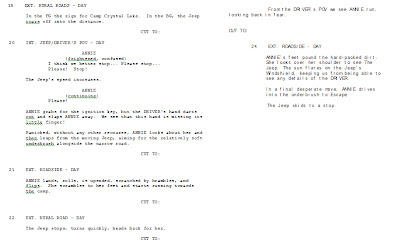In order to produce an accurate script for my film I will annotate some iconic horror film scripts. By looking at a few and establishing some common codes and conventions I can apply them to my work and therefore better my production resulting in my audience being more satisfied and meeting there needs.
This is part of the script for the original Friday 13th scripted by Victor Miller. First feature I noticed about the script was that it had numbered each shot to make the script be interpreted easily and it comes across as more organized. The tittle and description of the shot is also included in the script, i.e. EXT. ROADSIDE, there is a lot of use of abbreviations in the script, which must be used for convenience to the scriptwriter. Names are also seen in capitals for e.g. ANNIE, this is so names can be easily picked out in the script. Setting is included in the script and each shot number is also given a DAY/NIGHT mention this is especially important in Horror films as the transition between night and day can be decisive in effect to the audience, this needs to be clearly stated because certain shots will only take effect when particular Mise-en-scene is present. There is also use of ellipsis in the script to represent silence or a pause before/after speech. Abbreviations also represent media terminology, for instance POV (point of view) and BG (back ground).
Haloween.
This script was written by John Carpenter and Debra Hill. This script shows a lot more detail towards the content for instance, ANGLE on [Subject] helps the script be easily interpreted and also the names are in CAPITAL letters to easily distinguish the different names. This script also uses abbreviation such as POV. Capital letters also symbolize emphasis on certain parts of the script, i.e. ‘SLAMS’. In contrast to the Friday 13th script, this one shows a lot more direction for the production team and allows each part to be easily understood.


No comments:
Post a Comment